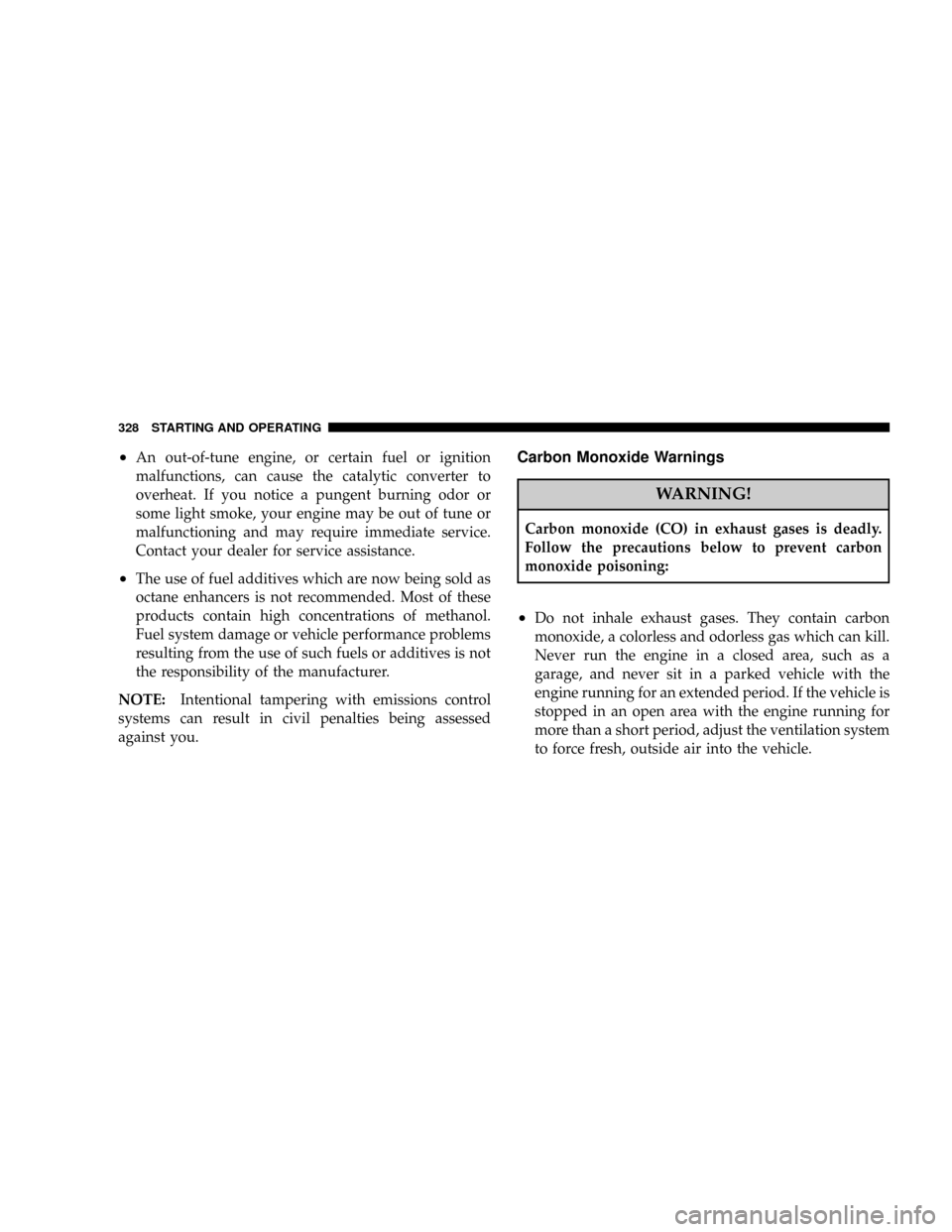Page 188 of 457

WARNING!
A hot engine cooling system is dangerous. You or
others could be badly burned by steam or boiling
coolant. You may want to call a service center if your
vehicle overheats. If you decide to look under the
hood yourself, see Section 7 of this manual. Follow
the warnings under the Cooling System Pressure Cap
paragraph.
3. Fuel Gauge
The pointer shows the level of fuel in the fuel tank when
the ignition switch is in the ON position.
The Low Fuel Light will turn on when the fuel level
reaches approximately 2 to 4 gallons (7 to 15 liters)
this light will remain on until fuel is added.4. Turn Signal Indicators
The arrow will flash with the exterior turn signal
when the turn signal lever is operated.
If the vehicle electronics sense that the vehicle has
traveled about one mile with the turn signals on, a chime
will sound to alert you to turn the signals off. If either
indicator flashes at a rapid rate, check for a defective
outside light bulb.
5. Speedometer
Indicates vehicle speed.
6. Anti-Lock Brake Light
This light monitors the Anti-Lock Brake Sys-
tem. The light will turn on when the ignition
switch is turned to the ON position and may
stay on for as long as four seconds.
If the ABS light remains on or turns on while driving, it
indicates that the Anti-Lock portion of the brake system
188 UNDERSTANDING YOUR INSTRUMENT PANEL
Page 197 of 457

For additional information on Tire Pressures, refer to
Section 5 Ð Starting and Operating, ªTire Inflation
Pressuresº of this manual.
22. Airbag Light
This light turns on and remains on for 6 to 8
seconds as a bulb check when the ignition
switch is first turned ON. If the light is not on
during starting, stays on, or turns on while
driving, have the system inspected by an authorized
dealer as soon as possible.
23. Electronic Vehicle Information Center Display Ð If
Equipped
When the appropriate conditions exist, this display
shows the Electronic Vehicle Information Center (EVIC)
messages.
24. Engine Temperature Warning Light
This light warns of an overheated engine condi-
tion. If this light is accompanied by a continuouschime, the engine temperature is critically hot, and the
vehicle should be turned off immediately. The vehicle
should be serviced as soon as possible.
25. Liftgate Ajar Ð If Equipped
This light turns on if the liftgate is not com-
pletely closed.
26. Door Ajar Light Ð If Equipped
This light turns on if a door is not completely
closed.
27. Washer Fluid Light Ð If Equipped
This light turns on when the washer fluid level
falls below approximately 1/4 filled. The light will
remain on until fluid is added.
UNDERSTANDING YOUR INSTRUMENT PANEL 197
4
Page 267 of 457

²While holding the recirculation button, turn the igni-
tion switch to the ªRUNº position.
²Continue holding the recirculation button for 4 sec-
onds, then release.
The recirculation control is now programmed so that the
recirculation mode willnotreset to the outside air mode
when the engine is restarted. The recirculation program-
ming can be changed back by repeating this procedure.
Rear Blower Operation
To operate the rear fan, press the9REAR9button. The first
time this button is pressed the9REAR AUTO9display
will illuminate indicating that the rear fan speed is
automatically controlled. To manually control the rear
fan speed, press the9REAR9button again and only
9REAR9will illuminate in the display. This allows the rear
seat occupants to control the rear fan speed using theswitch located in the center console between the second
row seats. By pressing the9REAR9button a third time,
the rear fan will shut off.
When the ATC display reads9REAR AUTO9or when the
rear fan is off, the switch located in the center console
between the second row seats is not functional. When the
ATC display reads9REAR9, only the rear seat occupants
can control the rear fan speed from the rear switch. When
in the ªREARº mode, the rear occupants can set the rear
switch to any fan speed including9OFF9,or9AUTO9.
While in the9AUTO9position, the rear fan speed will be
automatically controlled.
Summer Operation
The engine cooling system in air conditioned vehicles
must be protected with a high-quality antifreeze coolant
to provide proper corrosion protection and to protect
against engine overheating. A 50% solution of ethylene
UNDERSTANDING YOUR INSTRUMENT PANEL 267
4
Page 275 of 457
STARTING PROCEDURES
Before starting your vehicle, adjust your seat, adjust both
inside and outside mirrors, and fasten your seat belts.WARNING!
²Be sure to turn off the engine and remove the
key from the ignition switch if you want to rest
or sleep in your car. Accidents can be caused by
inadvertently moving the gear selection lever or
by pressing the accelerator pedal. This may
cause excessive heat in the exhaust system, re-
sulting in overheating and vehicle fire which
may cause serious or fatal injuries.
²NEVER
leave children alone in a vehicle. Leaving
children in a vehicle unattended is dangerous for a
number of reasons. A child or others could be
seriously or fatally injured. Don't leave the keys in
the ignition. A child could operate power win-
dows, other controls, or move the vehicle
²Do not leave children or animals inside parked
vehicles in hot weather. Interior heat build up
may cause serious injury or death.
STARTING AND OPERATING 275
5
Page 283 of 457

²Transaxle shifting will be more noticeable when Auto-
sticktis engaged.
²If a low range is selected and the engine accelerates to
the rev limit, the transaxle will automatically select the
next higher ratio.
²If a downshift would cause the engine to over-speed,
that shift will not occur until it is safe for the engine.
Mostly the transaxle will stay in the manually selected
ratio, however.
²If the system detects powertrain overheating, the
transaxle will revert to the automatic shift mode and
remain in that mode until the powertrain cools off.
²If the system detects a problem, it will disable the
AutoSticktmode and the transaxle will return to the
automatic mode until the problem is corrected.
CAUTION!
Damage to the transmission may occur if the follow-
ing precautions are not observed:
²Shift into PARK only after the vehicle has come to
a complete stop.
²Shift into or out of REVERSE only after the
vehicle has come to a complete stop and the engine
is at idle speed.
²Do not shift from REVERSE, PARK, or NEUTRAL
into any forward gear when the engine is above
idle speed.
²Before shifting into any gear, make sure your foot
is firmly on the brake pedal.
STARTING AND OPERATING 283
5
Page 328 of 457

²An out-of-tune engine, or certain fuel or ignition
malfunctions, can cause the catalytic converter to
overheat. If you notice a pungent burning odor or
some light smoke, your engine may be out of tune or
malfunctioning and may require immediate service.
Contact your dealer for service assistance.
²The use of fuel additives which are now being sold as
octane enhancers is not recommended. Most of these
products contain high concentrations of methanol.
Fuel system damage or vehicle performance problems
resulting from the use of such fuels or additives is not
the responsibility of the manufacturer.
NOTE:Intentional tampering with emissions control
systems can result in civil penalties being assessed
against you.
Carbon Monoxide Warnings
WARNING!
Carbon monoxide (CO) in exhaust gases is deadly.
Follow the precautions below to prevent carbon
monoxide poisoning:
²Do not inhale exhaust gases. They contain carbon
monoxide, a colorless and odorless gas which can kill.
Never run the engine in a closed area, such as a
garage, and never sit in a parked vehicle with the
engine running for an extended period. If the vehicle is
stopped in an open area with the engine running for
more than a short period, adjust the ventilation system
to force fresh, outside air into the vehicle.
328 STARTING AND OPERATING
Page 349 of 457
WHAT TO DO IN EMERGENCIES
CONTENTS
mHazard Warning Flasher..................350
mIf Your Engine Overheats.................351
mJacking And Tire Changing................352
NJack Location........................352
NSpare Tire Stowage....................354
NPreparations For Jacking................355
NJacking Instructions....................356
mJump-Starting Procedure..................360mFreeing A Stuck Vehicle..................362
mTowing A Disabled Vehicle................363
NWith Ignition Key.....................363
NWithout The Ignition Key...............365
NTowing This Vehicle Behind Another Vehicle
(Flat Towing With All Four Wheels On The
Ground)............................365
NTowing This Vehicle Behind Another Vehicle
With A Tow Dolly.....................365
6
Page 351 of 457

NOTE:With extended use, the Hazard Warning Flash-
ers may wear down your battery.
IF YOUR ENGINE OVERHEATS
In any of the following situations, you can reduce the
potential for overheating by taking the appropriate ac-
tion.
²On the highways Ð Slow down.
²In city traffic Ð While stopped, put transmission in
neutral, but do not increase engine idle speed.
NOTE:There are steps that you can take to slow down
an impending overheat condition. If your air conditioner
is on, turn it off. The air conditioning system adds heat to
the engine cooling system and turning off the A/C
removes this heat. You can also turn the Temperature
control to maximum heat, the Mode control to floor, andthe fan control to High. This allows the heater core to act
as a supplement to the radiator and aids in removing heat
from the engine cooling system.
CAUTION!
Driving with a hot cooling system could damage
your vehicle. If temperature gauge reads ªHº, pull
over and stop the vehicle. Idle the vehicle with the air
conditioner turned off until the pointer drops back
into the normal range. If the pointer remains on the
ªHº, turn the engine off immediately, and call for
service.
WHAT TO DO IN EMERGENCIES 351
6